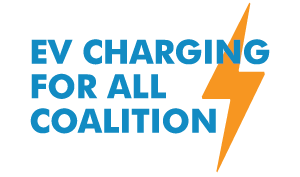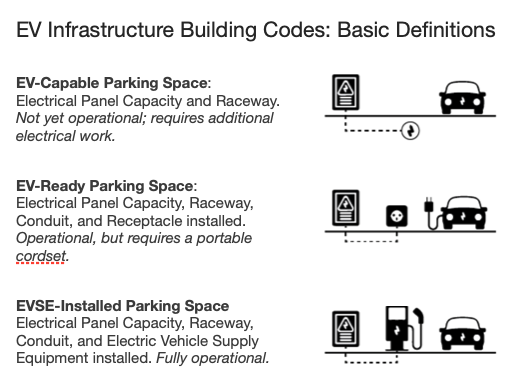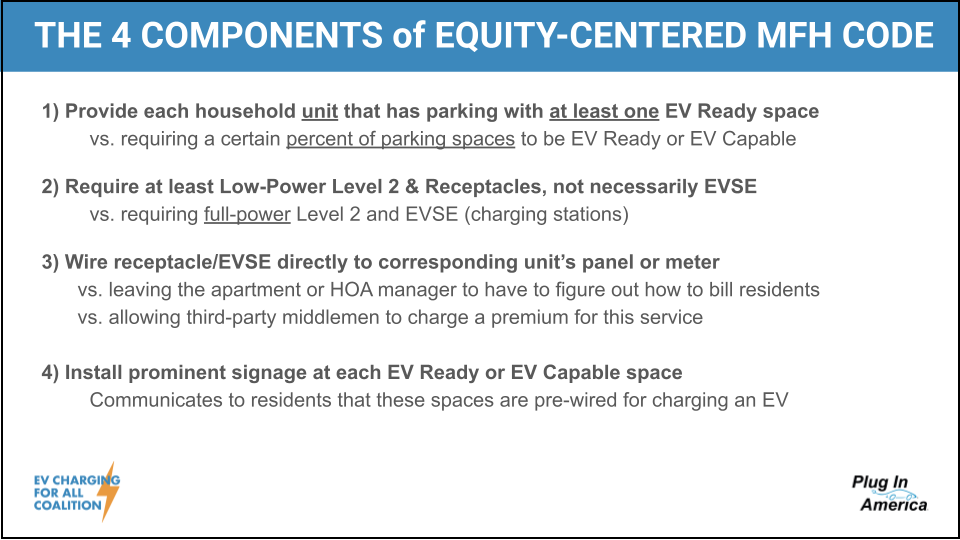 Building Codes for Equitable, Ubiquitous EV Charging Infrastructure
Building Codes for Equitable, Ubiquitous EV Charging Infrastructure
The EV Charging for All Coalition works with state-based organizations throughout the US to advocate for EV Readiness building codes. Our two guiding principles:
- Maximize equitable, affordable access to “EV Ready” (plug-and-play*) charging at home and at work;
- Minimize cost and complexity for residents, builders and property managers.
NEW in October 2024: The release of our EV Building Codes Toolkit
Where Do We Work?
Our state-based coalitions advocate locally to strengthen existing building codes, and to advance state legislation when necessary to secure EV charging access for all. California was the birthplace of the EV Charging for All Coalition – you can read about their ongoing work with our California partner, Acterra. We are building out EVCAC coalitions in other states; we also convene the EV Working Group for the national 2024 IECC code-making process. If you’d like to get involved, please email vanessa.warheit@acterra.org.
Why Focus on Infrastructure?
Rapid, widespread EV adoption is required to address climate breakdown and unhealthy air quality. We must ensure that all members of society have access to the health, economic, and climate benefits of electrified transportation, and address barriers to EV adoption as quickly as possible. One major barrier is a lack of access to charging infrastructure – particularly for residents of multi-family housing (MFH). While many programs focus on consumer awareness and EV financing, drivers also need access to reliable, safe, and affordable charging in order to make the switch to electrified driving.
 Why Focus on Multi-Family Housing and Workplace Charging?
Why Focus on Multi-Family Housing and Workplace Charging?
Residents of Multi-Family Housing are more likely to be lower income, BIPOC (Black, Indigenous, and/or People of Color) and/or members of historically polluted communities. As such, they stand to benefit the most from the financial, environmental and health benefits of plug-in driving. Yet MFH residents face numerous, often insurmountable challenges in accessing EV charging infrastructure at home.
The cheapest, safest, and most convenient place to charge an EV is at home – and the workplace is the next best location. Home and work are the ‘long dwell time’ places where cars tend to sit parked for many hours at a time.
Since light-duty cars in the US are driven an average of only 39 miles/day, inexpensive low-level charging is more than sufficient for the vast majority of home and workplace charging. Lower-level charging is cheaper to install, cheaper to the end user, and easier on the grid.
Why Focus on Building Codes?
Building codes are the rules that inform how developers and builders can and must build; they ensure that our built environment is safe and healthy. But building codes often reflect structural inequities.
Like unelectrified parking, ‘cold water flats’ (apartments without hot water plumbing) used to be the norm for multi-family buildings, with residents of low-income housing relegated to boiling water on the stove for bathing and washing. Changes to the building codes required builders to create more equitable buildings that now provide access to hot water for everyone.
Today, building codes need to be changed again, to ensure equitable, affordable access to EV charging. This time, they must require “EV Ready” plug-and-play access for every resident with parking in all newly-built homes – whether single family, duplex, or multi-family housing.

Why Focus on New Construction? (What About Retrofits?)
EV infrastructure should be installed, wherever and whenever possible, at the time of new construction because the cost is a fraction of the price of a future retrofit. While retrofits are important (and we need to get codes for those too!), they are more expensive; it makes prudent financial sense to ensure our brand-new buildings are built for the electrified future – not for the fossil-fueled past.
Who Else is Working On This?
The EV Charging for All Coalition includes the Union of Concerned Scientists, GreenLatinos, Sierra Club California, the Electric Vehicle Association, and Interfaith Power & Light, among others. You can see the full list of individual and organizational supporters here.
EV Charging Equity Resources
- Letter from EV Charging For All Coalition to CA Governor Gavin Newsom
- Narrowing the Divide: Addressing Inequities in California’s EV Infrastructure, Harvard Progressive Policy Review
- How California is Keeping EVs Out of Reach for Apartment-Dwellers, HuffingtonPost
- A Battle Over Building Codes May Be The Most Important Climate Fight You’ve Never Heard Of, Huffington Post
- How to Charge Your Electric Car at Home, Consumer Reports
- EVs Offer Big Savings Over Traditional Gas-Powered Cars, Consumer Reports
- Help Us Make EV Charging Accessible to All, Acterra blog
- California Must Ensure EV Charging Access for All, CalMatters Op-Ed by Sen. Ben Allen and Asm. Mia Bonta
- EV Charging Deserts Leave Black Communities Unconnected, Washington Post
- Electric vehicles and charging dead zones in California: Why owning an EV isn’t easy for everyone, KCRA TV
* “EV Ready” is defined as an EV parking space with a receptacle or EVSE, connected via a dedicated branch circuit to a panel with capacity for EV charging. This is not the same as “EV Capable,” which requires panel capacity, a dedicated circuit and raceway, but does not (yet) include a way for someone to plug in and charge. While “EV Capable” is appropriate for new single family housing, for residents of multi-family housing – who lack the resources, incentives, and authority to hire an electrician to upgrade their building’s electrical system – “plug-and-play” EV Ready infrastructure is essential to ensure equitable EV charging access.
Want to receive our Plug Into Policy monthly newsletter?
You can be the first to know when we publish new reports. Sign up in just a few seconds.